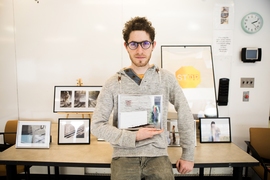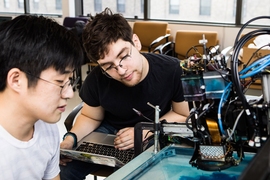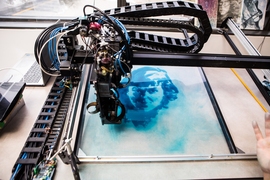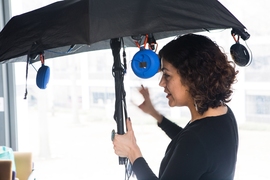When MIT graduate student Matthew Claudel learned of the student computing challenges launched to accompany the three-day celebration of the MIT Stephen A. Schwarzman College of Computing that begins today, he eagerly signed on.
“We were excited about extending the definition of computation and exploring how it might relate to the arts,” says Claudel, who is studying in the Department of Urban Studies and Planning.
The Computing Connections Challenges involved monthlong challenges with themes such as connecting arts, community, and computing, or using machine learning to explore cross-disciplinary topics including health care, transportation, privacy, ethics, architecture, design, commerce, finance, poverty, neuroscience, linguistics, and more. Other challenges involved the application of computing to finance and to the world of sports.
Participants came from all five of the Institute’s schools, and a Computing Exposition today will include top entries from the challenges, as well as interactive demonstrations that illustrate the ways in which MIT is advancing computing across disciplines.
Celebrations of the new college began over the weekend with a free film series on computing hosted by the MIT Lecture Series Committee, which has been bringing entertainment to campus since 1944. The events continue Feb. 26-28, with three days of programming with the themes of “explore,” “teach,” and “celebrate.”
For the “Connect Arts, Community, and Computing Challenge,” Claudel and Kimberly Smith SM ’17, who studied media arts and sciences, created an augmented reality mobile application called New Gravity, which paints the sphere atop the Green Building with a color scheme derived from the mathematics of gravitation and includes graphics that demonstrate gravitational waves.
“Neither of us are computer scientists, but both of us have collaborated extensively with computer scientists. We see an incredible future where the College of Computing channels the collaborative potential of disciplines such as arts, urban science, education, or astrophysics,” says Claudel.
“New Gravity is a thoroughly MIT kind of monument. It’s beautiful and it’s a bit quirky. It merges art and science, digital and physical. It’s shared among us, the MIT community, and with the city around us. New Gravity invites us all to stand, for a moment in awe as the distance to the Green Building collapses into a phone and expands to 1.3 billion light years,” he says.
Over the past several weeks, MIT students have dedicated their free time to such computing challenges, including the Connect Arts, Community, and Computing Challenge and the Machine Learning Across Disciplines Challenge, which were both funded by the MIT-IBM Watson AI Lab. Host partners for the challenges include the Arts at MIT, Computer Science and Artificial Intelligence Laboratory, Martin Trust Center, School of Engineering, the MIT Quest for Intelligence, and the Undergraduate Association. Many of the student creations are on display today in Memorial Lobby (Building 10) and at the Ray and Maria Stata Center and the Koch Institute.
MIT graduate student Tianyu Su from the Department of Urban Studies and Planning says his team of student researchers and designers from MIT and Harvard University joined the arts and community challenge to learn from each other and from other teams.
“We all have a strong interest in how we could better interact with the emerging technologies and how to apply them into underrepresented communities,” says Su, whose team, Eco-LIVE, applied emerging technology — including augmented reality and computational modeling — to design ecological education that integrates playfulness, cohesiveness, and accessibility in community education.
“We are excited. We can see so many new possibilities in the new college and look forward to the coming activities,” he says.
A workshop in early February reflected the student excitement around the mural augmentation project that was one option within the Connect Arts, Community, and Computing Challenge. During the workshop, MIT junior Jierui Fang, an art and design major who is minoring in computer science, helped coach student participants.
“The College of Computing isn’t just about computation,” Fang said at the time. “I think it’s really important that people are aware that MIT students are very multifaceted. We have different aspects to our personalities and different passions.”
Fang is a member of the Borderline Student Group, which together with more than 20 artists created a connected, augmented mural with animations in the tunnels under campus. During the challenge, she and other Borderline members offered other students help with augmenting images.
The multifaceted nature of MIT students was clear from the playful top entries, which can be viewed by holding a mobile device in front of murals in the Stata Center while running an application called Artivive that overlays the student animations onto the canvas.
First-year student Heya Lee created a digital animation of a butterfly in flight against the backdrop of an autumn day. Natasha Hirt, also a first-year student, developed animation that swirls and blurs across a mural featuring an image of the Stata Center. Second-year architecture students Jacqueline Chen, Peiling Jiang, and Yi Yang joined with second-year mathematics student Wanyi Xiao to develop an animation of a creature climbing a tree in a mural developed in a collaboration with MIT and the Suffolk County House of Corrections.

















